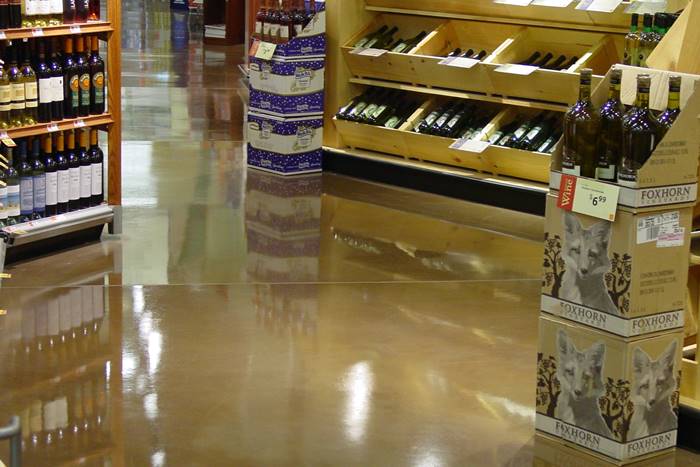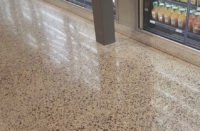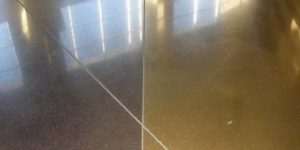
One message comes through loud and clear in any discussion, debate or disagreement about the various types of densifiers and techniques for applying concrete densifiers on concrete polishing.
Almost all of them work. (With one exception — read on.)
Beyond that point of essentially universal agreement, the discussion takes on a different spin, addressing the sometimes subtle attributes and pitfalls of using sodium, potassium or lithium silicates or the newer kid on the block, colloidal silica.
Then, with increasing emphasis, follows a second message: It’s about rejection.
While personal rejection can take a toll on one’s self-esteem, densifier makers and polished concrete contractors voice an agreement. A concrete surface’s rejection of additional densifier signals that the concrete has gotten the dose of treatment it needs to succeed in its mission of durability and visual enhancement.
“We tell contractors to densify until rejection,” says Brad Burns, executive director of the Concrete Polishing Association of America. “That way you have the best wear resistance possible for concrete.”
Densifier definition
A series of position papers and definitions developed by the CPAA addresses the characteristics and composition of densifiers, how best to use them, and a number of other key concrete polishing issues.
The definitions, found in the “Glossary” section of the CPAA website, include this entry on liquid densifiers:
“An aqueous solution of SiO2 (silicon dioxide, or silica) dissolved in the respective Hydroxide that penetrates into the concrete surface and reacts with the Calcium Hydroxide to provide a permanent chemical reaction that hardens and densifies the wear surface of the cementitious portion of the concrete.”
The definition lists four types: sodium silicate, potassium silicate, lithium silicate, and an “alkalis solution of colloidal silica or silicates.”
CPAA defines densifiers “to help architects understand that all densifiers harden the concrete,” Burns says. “That being said, they’re not all the same. One may perform quicker or better than another. That’s where contractors learn to use different brands. It’s not necessarily the chemistry, it’s the formula.”
Burns also notes that colloidal silica suspended only in water would be nonreactive. That’s his exception to the idea that “they all work.”
Different types, different practices
So what about these various types of densifier? Let’s look at what seasoned experts say with regard to how they work in practice, and about how to ensure the densifier does the job of densifying most effectively.
“They all perform the same way,” Burns says. “Regardless of what you use as a carrier, the silicate does the work.
“With sodium, you put down a lot of liquid, scrub, and clean the surface. If you are going to be applying concrete densifiers early in the process, there’s no need to worry about getting it off the surface because it will be ground off.”
In marketing spin, manufacturers advertise lithium as easier to apply. Nevertheless, Burns cautions that “in the real world,” the same rules apply: If the concrete surface is porous, more densifier is required. “It’s about application at the job site and determining what the variables are,” he says.
“With lithium, the manufacturers advise use of less material, so you must make sure you get plenty of densifier in the concrete.”
Apply until rejection
Potassium silicate hardeners are applied in a similar fashion to sodium silicates. You essentially flood the surface and scrub the solution into the concrete. On the other hand, colloidal silicas are used more like lithium silicates, with a sprayer and a microfiber applicator.
The CPAA gets no argument from manufacturers on the matter of application to the point of rejection.
“To comply with the ATSM method of application you need to flood the floor with the silicate for a minimum of 30 minutes or until it will not accept any more material,” says Scott Thome, director of product services for L. M. Scofield Co. Scofield offers a trio of densifier chemistries — sodium, potassium and lithium.
The square-foot coverage rate of a silicate is between 400-500 square feet per gallon on a normal concrete substrate. Applying them at 800-1,000 square feet per gallon “is just not enough,” Thome says. By the time the contractor puts two to three sets of diamonds on the floor after applying the silicate, it could easily be removed. The floor will then perform as if you had never applied silicate.
Thome also offers the following recommendations and suggestions:
- When you apply lithium silicate to the floor and allow it to dry, it develops a film on the surface resembling crushed glass. This can be difficult to remove. This material is the silicate component in a dry phase. When the residual silicate is allowed to dry and there are no signs of film development, a question arises as to what the actual solids content of that particular material is. You should test and use each material to determine which one works best.
- Sodium silicates are well suited for large warehouse applications that are not “architectural.”
- Potassium silicates are recommended for architectural floors that are gray or integrally colored and are to be chemically polished.
Scofield considers lithium silicate a “default” densifier. It regards it as easy to apply, as it needs minimal agitation for penetration. Once the floor has been saturated and will not absorb more material, the excess should be removed unless metal bond diamonds will be used after the silicate has been placed.
Optimum application amounts
Mark Vogel, director of international sales for W.R. Meadows Inc., says manufacturers are moving away from the “ease of application” pitch toward emphasizing the need to saturate the surface to get proper densification. “It’s simple and it’s true,” he says.
“When lithium first came out, the manufacturers said just mist it, wipe it and are you good to go. That’s nowhere near what’s needed,” he says. “It was said it could do 1,000 square feet per gallon. This resulted in soft areas and premature erosion.”
Densifying to rejection, in contrast, addresses variations in hardness typical in any concrete slab, he notes.
Unlike “drowning the surface” with sodium silicates, the recommendation for lithium silicates is to aim for an optimum application amount with the sprayer and microfiber mop.
“The key is knowing and understanding concrete and watching. The first 10 minutes are the most crucial, when you see if the concrete is absorbent or not absorbent. Then you either add more or, if it’s not absorbing, you wait a little longer to see if it does absorb. If there still is a sufficient amount on the surface, you don’t do anything.
“The key is the applicator judging absorbance and how much to get into the concrete.”
Read the floor
Joe Reardon of Prosoco Inc., a maker of lithium silicate densifiers, agrees that the contractor must “read the floor and how much it’s going to take”: maybe at a high rate of 300 square feet per gallon if it’s soft, two coats if it’s “really soft.”
But Reardon adds that oversaturation with lithium silicates can cause “whitening out” of the surface. This consists of a layer of excess silicate difficult to remove due to lithium’s insolubility in water.
“It really comes down to the applicator knowing the situation with the floor. We rely on them to read that floor,” he says.
Colloidal silica densifiers are the claim to fame for Lythic Solutions Inc. Its president, David Loe, says ultra-low levels of metallic salts in colloidal-silica densifiers prevent the whitening problem. The products’ low pH addresses the matter of worker safety and hazardous-materials disposal. Other favorable characteristics, he says, are low viscosity and rapid rates of penetration and reaction with concrete.
To get optimal results when applying concrete densifiers, Loe offers the following recommendations:
- Make sure the surface has no contamination of oils or other substances that may prevent densifier penetration.
- On the treated concrete, test the densifier performance. All slabs differ, and different pours on the same slab differ. Additionally, concrete placed on different substrates (on-grade versus on deck) from the same pour can differ.
- Follow the manufacturer’s directions carefully. Above all, this is crucial with silicates, where the margin for error is small if you aim to avoid whiting. Overapplication of silicates can cause whiting, but underapplication will mean lack of densification.
- Call the manufacturer immediately with any questions or problems.
Question from Readers
Question
Can you color concrete after applying lithium silicate?
Answer from Concrete Decor
You should always apply color to the concrete before you apply the densifier. Densifier reacts with cement at the surface which makes it nearly impossible to get color to bond with the concrete surface.
If you polish the slab according to ACI 310 specifications you may be able to go back in the metal bond grinding process and remove more surface. Consequently, this will give the color a surface to adhere to before redensifying and then proceeding with transitionals or resin-bond diamonds. If you don’t polish, you can add color to a seal coat and achieve either a transparent or opaque-colored finish.
















